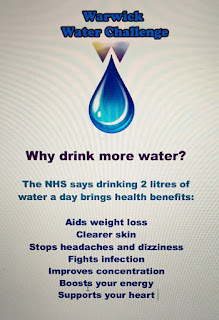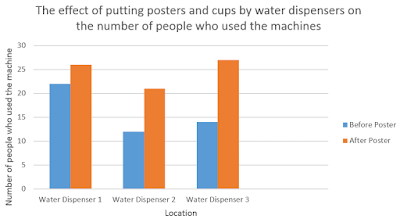Most people already know that drinking water is good for us. But how many of us actually drink the recommended 2 litres a day? We believe that it is important to promote the benefits surrounding consuming enough water to students at the University of Warwick. As exams draw closer and deadlines loom, the cognitive and performance based benefits that water can offer are more important than ever.There is a wealth of research which demonstrates the importance of drinking enough water. For example, drinking water before a test improved people’s scores as well as their mood (Edmonds & Jeffes, 2009). Drinking sufficient water also means that the body can operate efficiently and optimally, which is vital during the stress of exams and deadlines.Our project was aimed at making the benefits of drinking water salient in order to encourage students to drink more. In order to do this, we placed posters above and next to various water dispenser machines in high-traffic areas around the university campus. We used big, bold fonts and bright colours on the posters to catch the eyes of passers-by, and bring their attention to the free water they could get from the dispensers. We also made badges with a distinctive water-drop logo on, as used in the posters, and offered these to people who had used the machines. This used the behavioural influence technique of salience (Chaiken & Eagly, 1983), which means that the behaviour of drinking water was brought to their attention. 


We also placed cups next to the dispensers so people could quickly and easily get a drink of water. This was based on the opportunity part of the framework of behavioural influences by Fishbein et al. (2001). This means that a behaviour can only occur if the individual has sufficient opportunity to complete it. By providing cups we were making sure that every passer-by had the opportunity to drink water, not just those who already had a water bottle to fill up. The posters we displayed also contained the health benefits of drinking water. This was based on the central route processing of the Elaboration Likelihood Model (Petty & Cacioppo, 1986). We believed that this would be an appropriate way of persuading students as they are an educated audience who will therefore be more influenced by a strong factual message. To measure if our intervention led to behaviour change we compared the amount of people using the water dispensers before the posters and cups and afterwards. We took a baseline tally score for each water dispenser over an hour period. We used an hour long period so that there would be movement between lectures. We then put the posters up and supplied the cups and did a second tally score of how many people used the dispenser. The baseline test and intervention test was both completed on the same day. We found that there was an increase in the number of people using the machines after we put up the posters and put the cups next to the machines, suggesting these helped people to change their behaviour and drink more water from the dispenser machines. This suggests that by making a behaviour salient and providing adequate opportunity for people to complete the behaviour, people are more likely to drink more water. This technique could be used to encourage other forms of positive behaviour around campus such as putting your litter in the bin and turning off lights. The graph shows the number of people who used each water dispenser before and after the posters and cups were put by the machines.
 Preeya ChibbraSandev PanaserBecky SeversReferences: Chaiken, S., & Eagly, A. H. (1983). Communication modality as a determinant of persuasion: The role of communicator salience. Journal of personality and social psychology, 45(2),241. Edmonds, C. J., & Jeffes, B. (2009). Does having a drink help you think? 6–7-Year-old children show improvements in cognitive performance from baseline to test after having a drink of water. Appetite, 53(3), 469-472. Fishbein, M., Triandis, H. C., Kanfer, F. H., Becker, M., & Middlestadt, S. E. (2001). Factors influencing behavior and behavior change. Petty, R. E., & Cacioppo, J. T. (1986). The elaboration likelihood model of persuasion (pp. 1-24). Springer New York.
Preeya ChibbraSandev PanaserBecky SeversReferences: Chaiken, S., & Eagly, A. H. (1983). Communication modality as a determinant of persuasion: The role of communicator salience. Journal of personality and social psychology, 45(2),241. Edmonds, C. J., & Jeffes, B. (2009). Does having a drink help you think? 6–7-Year-old children show improvements in cognitive performance from baseline to test after having a drink of water. Appetite, 53(3), 469-472. Fishbein, M., Triandis, H. C., Kanfer, F. H., Becker, M., & Middlestadt, S. E. (2001). Factors influencing behavior and behavior change. Petty, R. E., & Cacioppo, J. T. (1986). The elaboration likelihood model of persuasion (pp. 1-24). Springer New York.
#GiveLife
The aim of this project was to increase the number of people in the Warwickshire area who signed up to give blood. A large proportion of the population are able to give blood, and yet only 4% of people currently do, with the younger generation giving less blood than previous generations have. However, the demand for blood is high: around 8000 transfusions are carried out each day, and roughly 1 in 3 people will need a blood transfusion in their life.The social media campaign used an infographic and hashtag, which were repeatedly posted on Facebook by the members of the group over a short period of time. Using social media enabled us to track the responsiveness of our posts, through likes, shares, and follows. The campaign utilised persuasive techniques such as celebrity endorsements and guilt tripping to influence the reader’s decisions. By contacting Give Blood, the number of sign ups could be obtained. The effectiveness of our campaign would be shown though increased sign ups in the period during and after the campaign, compared to signs up in an equal period before the campaign. Targeted social media campaign using the hashtag #GiveLife
Targeted social media campaign using the hashtag #GiveLife The infographicMatthew ConnellJake DunkleyJoshua Mann
The infographicMatthew ConnellJake DunkleyJoshua Mann
Reducing Missed Appointments at the University of Warwick Health Centre
 Our group made a poster with the aim of reducing missed appointments at the University of Warwick health centre. We chose this topic because missed appointments cost the National Health Service (NHS) huge amounts of money every year, and on a smaller scale £160 per appointment missed.Hallsworth et al’s (2015) study found that informing patients that missing their appointment would cost the NHS £160 in their text message appointment reminder reduced missed appointments by almost a quarter. For this reason, we chose to emphasize this number on our posters. As research has shown salience is important in persuasion and that large bodies of text are often ignored (Vlaev, 2015), we designed the poster to have minimal text and the £160 figure large, attention-grabbing, and with a stack of money beneath. In the small amount of text we included two easy ways to contact the health centre to cancel appointments, by phone or text. We posted our poster on social media groups for University of Warwick students and at popular locations around campus.We used data from the University of Warwick health centre which records weekly missed appointments and compared data from the week before our posters were displayed, to the data from two weeks later. Missed appointment time decreased by approximately 3 hours, which we hope is as a result of our posters.ReferencesHallsworth, M., Berry, D., Sanders, M., Sallis, A., King, D. et al (2015). Stating appointment costs in SMS reminders reduces missed hospital appointments: Findings from two randomised controlled trials. PLoS ONE(10):10Vlaev, I. (2015) Salience. Unpublished raw data.Rachel FraserCarolyn NoorderhavenImogen O’MalleyKatie Kenton
Our group made a poster with the aim of reducing missed appointments at the University of Warwick health centre. We chose this topic because missed appointments cost the National Health Service (NHS) huge amounts of money every year, and on a smaller scale £160 per appointment missed.Hallsworth et al’s (2015) study found that informing patients that missing their appointment would cost the NHS £160 in their text message appointment reminder reduced missed appointments by almost a quarter. For this reason, we chose to emphasize this number on our posters. As research has shown salience is important in persuasion and that large bodies of text are often ignored (Vlaev, 2015), we designed the poster to have minimal text and the £160 figure large, attention-grabbing, and with a stack of money beneath. In the small amount of text we included two easy ways to contact the health centre to cancel appointments, by phone or text. We posted our poster on social media groups for University of Warwick students and at popular locations around campus.We used data from the University of Warwick health centre which records weekly missed appointments and compared data from the week before our posters were displayed, to the data from two weeks later. Missed appointment time decreased by approximately 3 hours, which we hope is as a result of our posters.ReferencesHallsworth, M., Berry, D., Sanders, M., Sallis, A., King, D. et al (2015). Stating appointment costs in SMS reminders reduces missed hospital appointments: Findings from two randomised controlled trials. PLoS ONE(10):10Vlaev, I. (2015) Salience. Unpublished raw data.Rachel FraserCarolyn NoorderhavenImogen O’MalleyKatie Kenton
- « Previous Page
- 1
- …
- 146
- 147
- 148
- 149
- 150
- …
- 558
- Next Page »